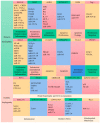The Pathogenesis of Diabetes
- PMID: 37108143
- PMCID: PMC10139109
- DOI: 10.3390/ijms24086978
The Pathogenesis of Diabetes
Abstract
Diabetes is the most common metabolic disorder, with an extremely serious effect on health systems worldwide. It has become a severe, chronic, non-communicable disease after cardio-cerebrovascular diseases. Currently, 90% of diabetic patients suffer from type 2 diabetes. Hyperglycemia is the main hallmark of diabetes. The function of pancreatic cells gradually declines before the onset of clinical hyperglycemia. Understanding the molecular processes involved in the development of diabetes can provide clinical care with much-needed updates. This review provides the current global state of diabetes, the mechanisms involved in glucose homeostasis and diabetic insulin resistance, and the long-chain non-coding RNA (lncRNA) associated with diabetes.
Keywords: diabetes; hyperglycemia; insulin resistance; long-chain non-coding RNA (lncRNAs); signal pathway.
Conflict of interest statement
The authors declare no conflict of interest.
Figures
Similar articles
-
Aberrant Expression of Long Non-Coding RNAs in Newly Diagnosed Type 2 Diabetes Indicates Potential Roles in Chronic Inflammation and Insulin Resistance.Cell Physiol Biochem. 2017;43(6):2367-2378. doi: 10.1159/000484388. Epub 2017 Oct 27. Cell Physiol Biochem. 2017. PMID: 29073614
-
Stress-Related LncRNAs and Their Roles in Diabetes and Diabetic Complications.Int J Mol Sci. 2025 Feb 28;26(5):2194. doi: 10.3390/ijms26052194. Int J Mol Sci. 2025. PMID: 40076814 Free PMC article. Review.
-
Circulating LncRNAs Analysis in Patients with Type 2 Diabetes Reveals Novel Genes Influencing Glucose Metabolism and Islet β-Cell Function.Cell Physiol Biochem. 2018;46(1):335-350. doi: 10.1159/000488434. Epub 2018 Mar 22. Cell Physiol Biochem. 2018. PMID: 29590649
-
Linking a role of lncRNAs (long non-coding RNAs) with insulin resistance, accelerated senescence, and inflammation in patients with type 2 diabetes.Hum Genomics. 2018 Aug 23;12(1):41. doi: 10.1186/s40246-018-0173-3. Hum Genomics. 2018. PMID: 30139387 Free PMC article.
-
Long noncoding RNA: an emerging player in diabetes and diabetic kidney disease.Clin Sci (Lond). 2019 Jun 20;133(12):1321-1339. doi: 10.1042/CS20190372. Print 2019 Jun 28. Clin Sci (Lond). 2019. PMID: 31221822 Review.
Cited by
-
Diabetic Wound Healing: Factors, Mechanisms, and Treatment Strategies Using Herbal Components.Curr Drug Targets. 2025;26(6):367-381. doi: 10.2174/0113894501354898241220075327. Curr Drug Targets. 2025. PMID: 39791148 Review.
-
CD8 T Cell Hyperfunction and Reduced Tumour Control in Murine Models of Advanced Liver Disease.Eur J Immunol. 2025 Aug;55(8):e70026. doi: 10.1002/eji.70026. Eur J Immunol. 2025. PMID: 40760842 Free PMC article.
-
High-dose sinomenine attenuates ischemia/reperfusion-induced hepatic inflammation and oxidative stress in rats with diabetes mellitus.Immun Inflamm Dis. 2024 Jun;12(6):e1271. doi: 10.1002/iid3.1271. Immun Inflamm Dis. 2024. PMID: 38888355 Free PMC article.
-
Triglyceride-glucose Index and Mortality in a Large Regional-based Italian Database (URRAH Project).J Clin Endocrinol Metab. 2025 Jan 21;110(2):e470-e477. doi: 10.1210/clinem/dgae170. J Clin Endocrinol Metab. 2025. PMID: 38482609 Free PMC article.
-
Association of Fat Mass and Obesity (FTO) rs9939609 Single Nucleotide Polymorphism (SNP) With Obesity and Type 2 Diabetes (T2D) in Healthy Young Adults in Kuwait.Cureus. 2025 Jan 7;17(1):e77110. doi: 10.7759/cureus.77110. eCollection 2025 Jan. Cureus. 2025. PMID: 39925495 Free PMC article.
References
-
- Saeedi P., Petersohn I., Salpea P., Malanda B., Karuranga S., Unwin N., Colagiuri S., Guariguata L., Motala A.A., Ogurtsova K., et al. IDF Diabetes Atlas Committee: Global and regional diabetes prevalence estimates for 2019 and projections for 2030 and 2045, Results from the International Diabetes Federation Diabetes Atlas, 9th edition. Diabetes Res. Clin. Pract. 2019;157:107843. doi: 10.1016/j.diabres.2019.107843. - DOI - PubMed
-
- Sun H., Saeedi P., Karuranga S., Pinkepank M., Ogurtsova K., Duncan B.B., Stein C., Basit A., Chan J.C.N., Mbanya J.C., et al. IDF Diabetes Atlas: Global, regional and country-level diabetes prevalence estimates for 2021 and projections for 2045. Diabetes Res. Clin. Pract. 2022;183:109119. doi: 10.1016/j.diabres.2021.109119. - DOI - PMC - PubMed
Publication types
MeSH terms
Substances
Grants and funding
LinkOut - more resources
Full Text Sources
Medical



